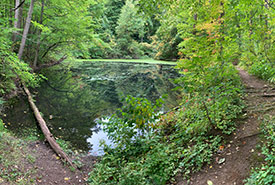A Bright Spot in a Bleak Year

Winter snowfalls transform the Bryce Canyon National Park Amphitheater into a Christmas-card-ready wonderland of white and fiery red.
After almost a year of isolation, lockdowns, mask-wearing, and strained relationships with family and friends, you might think that there’s not much good to say about 2020 as we come to its end. But today, I learned about a side effect of the COVID-19 pandemic that made me smile: 26 percent of people visiting parks during the early months of the crisis had rarely—or never—visited nature in the previous year.
And it’s not just me saying that, based on anecdotal evidence. That’s the finding of a brand-new study, published on December 17, 2020, in the science journal PLOS ONE. Despite media reports—and my personal experience—that suggest that more Americans are visiting nature during the pandemic, very few peer-reviewed studies have been published on the issue to date. The report is even more distinctive because it explores not only changes in our activities, but it also measures our values towards nature.
I would never say that we needed to have a global pandemic in order for the majority of us to finally realize the immense worth of the outdoors, but, at least, I think this marks a teensy, bright spot in a seemingly unending series of very bleak months.

In the dazzling Bryce Canyon National Park, you’ll find the largest concentration of hoodoos in the world.
The necessity of nature
For the PLOS ONE study, researchers surveyed visitors to 25 parks and natural areas around greater Burlington, Vermont, which has approximately 214,000 residents, or a third of the state’s population. The team polled a sample of more than 400 people as Vermont’s COVID-19 health protocols were introduced.
It was discovered that nearly 70 percent of park users had escalated their visits to natural locales. An overwhelming number of respondents—81 percent—reported that they felt these areas and access to them had an increased importance. Nearly 70 percent of first-time or infrequent visitors said seeking out nature during the COVID-19 pandemic was very important.

The arches, bridges, castles, columns, temples and windows of Bryce Canyon National Park are highlighted by the vivid colors typical of southern Utah.
Some of the park users’ most common reasons for visiting natural areas and parks were birding, connecting to nature, dog walking, exercising, getting outside and spending time with children. Sixty-six percent of people used natural areas to find peace and quiet, and 32 percent reported them as spaces for contemplation—activities shown to reduce stress.
The breather that is Bryce
Now, in the spirit of the holidays, I’d like you to take a stress-reducing breather by watching the short, 10-minute video of beautiful Bryce Canyon National Park, found below. Captured in 4K ultrahigh definition, you’ll visit stunning park sites, such as the Fairyland Loop Trail, Inspiration Point, the Mossy Cave Trail, the Navajo Loop Trail, the Peek-a-Boo Loop Trail, the Queens Garden Trail, Sunrise Point, Sunset Point and the Tower Bridge Trail.

Unlike its neighbors to the south—Grand Canyon and Zion National Parks—Bryce Canyon is fashioned with exquisite and intricate forms rather than grand, sweeping ones.
I can’t think of a better gift right now than a journey—virtual or otherwise—though the magical arches, bridges, castles, columns, temples and windows of Bryce Canyon National Park, all in the vivid Technicolor typical of southern Utah.
Unfortunately, infectious disease experts predict that viruses, such as those that cause COVID-19, will increase in frequency in the future. That’s why our pocket urban parks and grand-scale national parks, such as Bryce Canyon, are so vital for our own health and the wellness of our planet.
They unquestionably are our “true places.”
I wish all of you a safe holiday season.
Here’s to finding your true places and natural habitats,
Candy
About the author: Candice Gaukel Andrews View all posts by Candice Gaukel Andrews
A multiple award-winning author and writer specializing in nature-travel topics and environmental issues, Candice has traveled around the world, from the Arctic Circle to Antarctica, and from New Zealand to Scotland’s far northern, remote regions. Her assignments have been equally diverse, from covering Alaska’s Yukon Quest dogsled race to writing a history of the Galapagos Islands to describing and photographing the national snow-sculpting competition in her home state of Wisconsin.
In addition to being a five-time book author, Candice’s work has also appeared in several national and international publications, such as “The Huffington Post” and “Outside Magazine Online.” To read her web columns and see samples of her nature photography, visit her website at www.candiceandrews.com and like her Nature Traveler Facebook page at www.facebook.com/naturetraveler.




